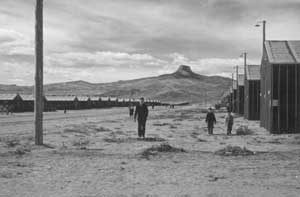MENU
|
| |
Confinement and Ethnicity: An Overview of World War II Japanese American Relocation Sites by J. Burton, M. Farrell, F. Lord, and R. Lord |

|
|
| |
Chapter 6 (continued)
Heart Mountain Relocation Center
Central (Fenced) Area
Other Areas
 Figure 6.26. Residential area, Heart Mountain Relocation Center. (Tom Parker photograph, Bancroft Library, University of California, Berkeley) |
On the lower terrace the locations of the hog farm, sewage treatment plant, and military police compound are now fields. The sewage disposal plant, a massive underground tank, likely remains buried. The swimming pool, which was likely never lined with concrete, is still evident as a depression, though silted in and overgrown with vegetation (Figure 6.29 and 6.30).
 Top
Top
Last Modified: Fri, Sep 1 2000 07:08:48 pm PDT
http://www.cr.nps.gov/history/online_books/anthropology74/ce6e.htm
![]()


